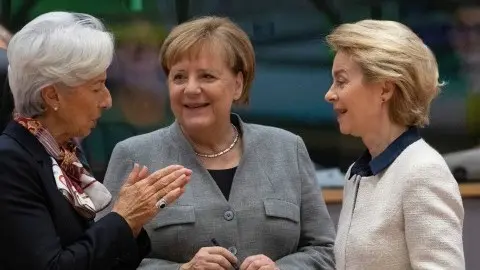Italy: Hardly growing, with lingering political risk
The Italian economy continues its very low growth spell, flirting with stagnation. The finalisation of the 2020 budget will likely absorb much of the government energy until year-end. The domestic political risk looks set to increase before a crucial regional election in late January
Still flirting with stagnation, with a bigger role for domestic demand
After a technical recession in 2018, the Italian economy has been experiencing quasi-stagnation ever since, with average quarterly growth at a meagre 0.08%. The headline GDP growth for 3Q19 was no different, but the demand breakdown changed somewhat. The net exports drive, which characterised 1H19, faded, with revived imports outweighing flattening exports.
The baton of growth was passed on to private consumption, which benefited from the combined effect of resilient employment and low inflation on disposable income. Interestingly, after being a drag for almost a year, inventories also provided a quarterly push to growth over 3Q19. The flat contribution of gross fixed capital formation looks like the logical result of persisting uncertainty on the US-China trade dispute, of softening manufacturing and of domestic political uncertainty, culminated in a change of government in August.
Softening investments were also consistent with business surveys, increasingly pointing to insufficient demand rather than insufficient factories/capacity as a limiting factor to their production activity.
Domestic demand is now the biggest contributor to growth

…and little scope for imminent acceleration
Data on 4Q19 looks consistent with a continuation of the soft economic patch. Confidence indicators have been sending mixed signals of late, with business confidence stabilising both in the manufacturing and in the service sectors; and consumer confidence falling. The PMIs dynamics was broadly consistent, pointing to a recession in manufacturing and to a mild expansion in services. Hard data available for October showed a decent labour market report conflicting with soft industrial production data, suggesting confirmation of the recent pattern.
The 0.2% MoM increase in employment and the concurrent fall of the unemployment rate to 9.7% seemed to support the idea that the past labour market resilience is still in place. This should in principle help confirm private consumption as a growth driver, at least in the short run. This is certainly possible, but some indicators are flagging the risk that fresh job creation might meet obstacles in the months ahead. In the November survey, consumers expressed increasing concerns on developments in unemployment over the next 12 months. Still, with inflation still tame, notwithstanding November’s uptick, we expect private consumption to remain supportive to growth in the short term.
Investment developments remain more uncertain. Bank lending to non-financial corporations adjusted for sales and securitisations are now firmly in contraction territory. Selective lending and limited appetite to borrow by very liquid high-quality businesses might be at the heart of the contraction in credit. Indeed, the October Bank of Italy’s Bank lending Survey signalled a marginal tightening of credit standards to NFCs in 3Q19 together with non-accelerating demand for loans. Lingering uncertainties in the international backdrop, with the US-China trade dispute, apparently not in for an imminent solution adds an element of caution on investment perspectives. Scarce visibility on domestic political developments complete the picture. Gross fixed capital formation will unlikely be a growth driver over 4Q19.
Looking into 2020, domestic demand should still characterise the first part of the year, where consumption inertia might get limited support from a mildly expansionary budget. An eventual rebalancing towards net exports seems crucially dependent on developments in the trade dispute.
New government, old problems
The Conte 2.0 government, backed by the 5SM, the PD, Italia Viva and Leu, devoted most of its debut time to craft a budget compatible with European constraints. The finance minister Gualtieri managed to strike a balance, submitting a mildly expansionary draft which solicited only moderate criticism from the Commission, without explicit requests for corrections.
The “pro-Europe” twist of the new government dramatically reduced the risk of a repetition of the “EDP threat” saga of the previous government, with a positive bearing on BTP-Bund spreads, which averaged around 130 bp over Sep-Oct. Still, this was not sufficient to strengthen the cohesion of the government alliance. The regional vote held in the small Umbria region late in October, marking a sharp fall for the 5SM, was a catalyst for political instability within the government alliance.
Since then Di Maio’s 5SM political leadership has been rather openly questioned by part of his party. In an attempt to re-affirm his leadership, Di Maio has again sought visibility with euro-critic calls. The attack of the League’s leader Salvini on PM Conte’s management of the ESM reform file offered Di Maio a convenient but slippery handle to ride the wave and flex his muscles before his government allies.
To be sure, being part of the government, he could not use the aggressive revamped anti-euro rhetoric used by Salvini but managed nonetheless to re-awaken doubts about whether the pro-euro conversion of the 5SM is genuine or not, prompting fresh tensions on spreads. We don't believe that he will push the situation so far as to induce a government crisis before the approval of the budget near the end of the year. Instead, we feel that the decision of the Eurogroup to delay the final approval of the ESM reform to 1Q20 might be enough to cool down a bit of the political temperature, at least in the very short term.
Political risk to rise as Emilia regional vote approaches
More crucially, the Italian domestic political risk might increase again as we get close to the regional election on 26 January 2020 in Emilia Romagna - a historical stronghold of the Italian left. There, the incumbent PD candidate will run against a contender from the League (supported by the whole right-centre). As the risk of a defeat for the PD is far from negligible (competing candidates are running neck and neck in the polls, with a small lead for the PD’s one as we write), this will represent a serious test for the survival of the current government alliance.
Unlike in the case of small Umbria, a defeat of the PD candidate in big Emilia would likely be heavily leveraged upon by the opposition in the national political debate. The destiny of the current government will thus likely depend on whether the PD, the 5SM and their smaller allies will be able to distil a synthesis on a revamped common program before that vote, to weather a possible storm in the polls.
Confirmatory referendum of constitutional law might add to political noise
Interestingly, the Emilia polling date will come soon after the deadline for the request of a confirmatory referendum on the Constitutional Law which trimmed the cumulative number of MPs from 945 to 600. Should the request be indeed submitted (the relevant collection of signatures is currently underway), the implementation of the law would be suspended until the referendum will be held (possibly in June).
This would open a February-June window of opportunity for a government crisis and for early elections to be held under the old rules, which would in principle "save" parliamentary seats for all participants. While not per se a decisive factor, this could turn out to be an incremental incentive to pull the plug should the tensions within the current coalition become unmanageable.
National opinion polls continue to point to right centre ample lead

A short-term compromise possible, but suspect it will not last long
Despite the above mentioned risks, we think that, for the time being, no party in the government has a strong incentive to pull the plug and provoke a government crisis and, therefore a snap election.
With opinion polls consistently pointing to a neat victory for a right-centre coalition led by the League, this could be political suicide. Among intense spikes of political noise, we still see room for a short-term compromise between members of the current majority, but remain skeptical this could last the entire legislature.
The Italian economy in a nutshell (%YoY)
This publication has been prepared by ING solely for information purposes irrespective of a particular user's means, financial situation or investment objectives. The information does not constitute investment recommendation, and nor is it investment, legal or tax advice or an offer or solicitation to purchase or sell any financial instrument. Read more
Download
Download article
16 December 2019
ING’s Eurozone Quarterly: Is this recovery for real? This bundle contains 13 Articles